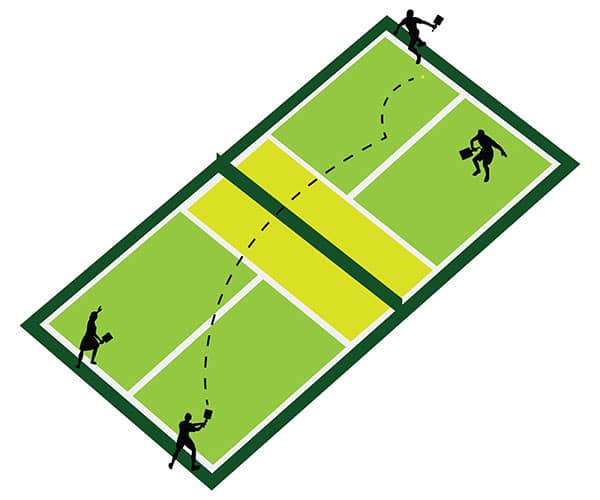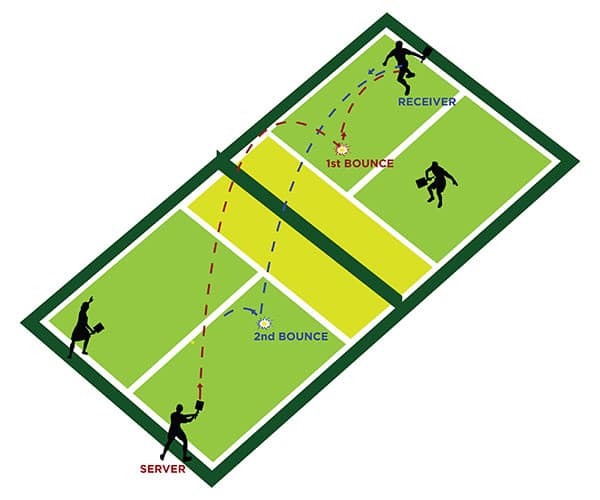An Overview of the Rules for Pickleball
The game of pickleball can be fun and exciting. It can also be a wonderful form of exercise while you spend time with friends. Don’t let the game intimidate you, as your skillset will improve the more you play. Here you will find an overview of the rules for pickleball so you can join in the fun! It is a great way to let your competitive nature out and challenge yourself to play better and better. These rules apply to all over the world, not just Winnipeg, so if you’re ever traveling, you’ll be playing the same rules.
Basics of the Game
You can play pickleball with two people (singles) or four people (doubles). The most common is four people at a time to cover the court. Two people are on each side of the net. The same size of court is used for singles or doubles and the same rules apply.
Serving
- When you serve, your arm must be arced upward when you hit the ball.
- The contact of the ball and paddle has to be done at the waist level or lower.
- The paddle shouldn’t be above the wrist when you contact the ball.
- If you complete a “drop serve,” all of the above serving rules are voided.
- When the ball is hit, the feet of the server must stay in bounds and can’t touch the centerline. At least one foot has to be behind the baseline.
- Serving is conducted diagonally across the court and it must stay in bounds on that side of the net.
- One serve can be attempted per turn.
Sequence for Serves
- A player or players if doubles, continue to serve and accumulate points until they fault. The exception is the first serve sequence of a new game.
- The initial serve for each side is made from the right side.
- When a point is scored, the server has to change sides and serve from the left. They continue switching as long as they make points.
- In doubles, when a server faults their partner will then start the above sequence for their turn to serve. When they commit a fault, serving then moves to the players on the opposite side of the net.
- The first serve is from the right and then the left. They continue as above until they commit a fault.
- Once a fault is made, it is then their partners turn to repeat the same process.
- When there is a new game started, only one partner has a chance to serve. When they fault, the other team gets a chance to serve.
Scoring Points
- Only the serving team can score points.
- A game ends when a single player or double team has 11 points and the opposing side is down by at least 2 points.
- For a tournament, scores are typically to either 15 or 21. This is determined before the tournament begins. The winning team must be at least 2 points head of the other team.
- When serving and the score is event, the first serve is from the right. When the score is odd, the first serve is from the left.
The Two- Bounce Rule
- The receiving team has to let the ball bounce before they can hit it after a serve. The serving team also has to let the ball bounce once before they can hit it back over the net.
- After the initial two-bounce rule for each serve, the players have the choice to hit it before it bounces (called a volley) or allow it to bounce (called a ground stroke).
- This rule is designed to remove the advantage of serving and volleying. It events the playing field.
Calls on the Line
- When a ball comes into contact with any line other than the non-volley zone, it is in.
- When a ball is in the non-volley zone, it is considered short and that is a fault.
The Non-Volley Zone
- This area extends 7 feet on both sides of the net.
- Volleying can’t take place in this zone. This ensures players can’t smack the ball from this position.
- If a player steps on the non-volley zone, including the line, it is a fault. Any part of their body or any item on them that touches this area is calls as a fault.
After a volley, if a player touches the non-volley zone, even if the ball is dead first, it is a fault. It doesn’t matter if they are moved forward due to momentum, it is still a fault! - A player can be in the non-volley zone during play as long as they aren’t volleying the ball while they are in that zone.
- Many players refer to the non-volley zone as “the kitchen.”
Faults
- When a fault occurs, it stops play because a rule has been violated.
- When the receiving team commits a fault, the serving team gets a point.
- When a serving team commits a fault, they lose their chance to keep serving.
Who Serves First?
A coin flip is typically used to determine who will serve first. That can also be used to determine who gets to choose which side of the net they start on.




